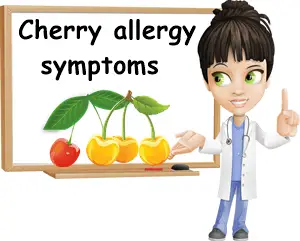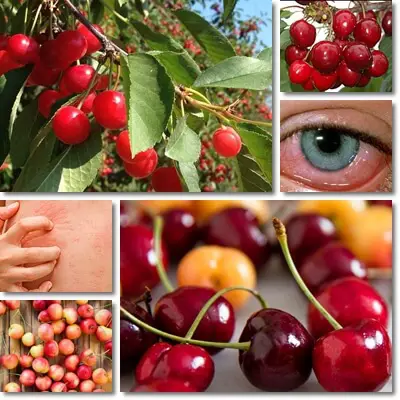Did you know you can be allergic to cherries? Of all foods, sweet cherries would seem the least likely to cause any side effects, let alone an allergic reaction. And yet, cherry allergy is a very real thing.
Cherry allergy is an uncommon food allergy with a relatively poor representation compared to more common food allergies such as milk, soy, nuts, peanuts, eggs or seafood.
Consumption of the raw and sometimes also cooked fruit can result in localized and systemic symptoms that build up to anaphylactic shock. Avoidance is the only real solution for preventing cherry allergy.
Read on to find out what is cherry allergy like, what causes a cherry allergy, what are the symptoms and treatment options.
What is cherry allergy?
Cherry allergy is a type of food allergy. It is an abnormal, excessive response of the immune system to otherwise harmless components occurring naturally in cherries.
A person who is allergic to cherries is not allergic to the whole fruit, but only to specific components in it, usually proteins. What happens is the immune system activates against proteins present naturally in cherries, triggering an abnormal and excessive reaction that seeks to destroy the otherwise harmless proteins. This results in specific symptoms affecting the skin, ears, eyes and nose, but also respiratory system and digestive system.
Cherry allergy can progress to anaphylactic shock which is a medical emergency that requires immediate medical assistance and prompt treatment.

(1) Cherry allergy: oral allergy syndrome
It is caused by eating raw, undercooked or, more rarely, cooked cherries or food products containing cherries (e.g. cherry pie, cherry ice cream, cherry juice). As suggested by the name, symptoms are usually restricted to the mouth and throat. Symptoms of oral allergy syndrome in response to eating cherries include itching or tingling of the lips, inside of the mouth, tongue or throat and typically also swelling of the lips, tongue, throat and uvula and changes in taste perception such as a metallic taste in the mouth.
In some cases, the swelling can be severe enough to impede normal breathing, requiring swift medical intervention and administration of emergency medication (typically the same as in anaphylaxis). Oral allergy syndrome caused by eating cherries can, in rare cases, produce systemic effects and culminate with anaphylactic shock.
Ingestion of cherries or food products containing cherries causes immune system activation against allergens in the fruit and subsequent release of histamine in the digestive tract. The release of histamine results in systemic symptoms, including digestive symptoms (nausea, vomiting, diarrhea, painful abdominal cramps), skin symptoms (hives – itchy bumps on the skin that are paler or redder than the surrounding skin), cardiovascular symptoms (low blood pressure, fainting, shortness of breath), respiratory symptoms (coughing, wheezing, asthma attack) and finally anaphylactic shock.
(2) Cherry allergy
Cherry allergy occurs in response to eating raw, undercooked or, more rarely, cooked cherries, and sometimes also dried cherries or food products containing cherries (e.g. cherry pie, cherry ice cream, cherry and other fruit juices with cherry). Cherry allergy may sometimes occur in response to only certain varieties of cherry (e.g. black cherries).
Cherry allergy is caused by proteins in the fruit that engage the immune system and elicit an excessive and abnormal reaction that causes the production of immunoglobulin E and histamine. This results in specific allergic reaction symptoms affecting multiple organs and systems.
Cherry allergy symptoms
Cherry allergy causes skin symptoms (hives – raised, itchy bumps that are paler or redder than the surrounding skin), symptoms affecting the eyes, nose and ears (redness, itchiness, burning sensation, swelling), digestive symptoms (nausea, vomiting, diarrhea, painful abdominal cramps), cardiovascular symptoms (low blood pressure, fainting, shortness of breath), respiratory symptoms (coughing, wheezing, asthma attack) and anaphylactic shock which is a medical emergency.

What causes cherry allergy?
What causes cherry allergy is proteins in the fruit which activate the immune system, triggering an excessive response. More exactly, some people’s immune system views certain proteins in cherries as dangerous and activates specific mechanisms meant to destroy them – the purpose is to eliminate the apparent threat represented by the proteins in the fruit.
What the immune system does is stimulate the production of immunoglobulin E and histamine in an effort to remove the allergens from the body, resulting in specific symptoms. Allergenic proteins in cherries include: Pru av 1, Pru av 2 and Pru av 3. These are classified as Pathogenesis-related (PR) proteins, that is, proteins with a plant-defense function that are produced when a plant is damaged, stressed or attacked by a pathogen.
An allergy to cherries may also indicate at least one other allergy to select fruits or vegetables or specific kinds of plant pollen. For example, cherries contain proteins that are structurally similar to allergenic proteins in peaches, apricots, apples, plums and walnuts and also birch pollen and alder pollen. A person that experiences symptoms of oral allergy syndrome after eating cherries may not necessarily be allergic to cherries, or just cherries, but to other fruits, vegetables or plant pollen which have structurally similar allergens and cross-contaminate cherries.
List of symptoms of cherry allergy
Symptoms of cherry allergy may vary from person to person and in intensity depending on the type and severity of the allergic reaction. Read below a complete list of symptoms to watch out for in cherry allergy:
- Oral allergy symptoms: itching or tingling of the lips, inside of the mouth, tongue or back of the throat, swelling of the lips, tongue, throat and uvula and changes in taste perception such as a metallic taste in the mouth.
- Skin symptoms: hives – raised, itchy bumps that are paler or redder than the surrounding skin, a rash.
- Symptoms affecting the eyes: red, itchy, watery eyes, swelling of the eyelids or area under the eyes.
- Symptoms affecting the nose: itchy, runny nose with abundant production of clear or white mucus or nasal congestion.
- Symptoms affecting the ears: itchy ears, burning sensation, redness and swelling.
- Respiratory symptoms: hoarseness, coughing, wheezing, sneezing, asthma attack, difficulty swallowing and difficulty breathing as a result of swelling and closing of the airways.
- Cardiovascular symptoms: low blood pressure, shortness of breath, pale skin, fainting.
- Digestive symptoms: nausea, vomiting, indigestion, painful abdominal cramps, loose stools and diarrhea.
- Neurological symptoms: lightheadedness, dizziness, confusion.
- Anaphylaxis or anaphylactic shock which is a medical emergency and requires immediate medical assistance and administering of life-saving medication to prevent fatal outcomes.
Symptoms of cherry allergy may occur almost instantly, within minutes of ingesting the fruit, or after a few hours or, more rarely, days following consumption of the fruit (24 to 72 hours). Symptoms may be restricted to the oral cavity and skin or gradually progress and affect all the main organs and systems. Progression to anaphylactic shock may take minutes, hours or days, depending on the case.
Treatment options
Avoidance
The best treatment for cherry allergy is avoidance of the fruit. If you know you are allergic to cherries or have experienced symptoms of an allergic reaction after eating cherries in the past, the best thing you can do is to not eat them anymore.
This includes the fresh and dried fruit as well as preparations from the fruit such as cherry juice, ice cream, cherry pie, pastry and more.
Note: Some people may experience cherry allergy only in response to eating fresh cherries or certain varieties of the fruit (e.g. black cherries), while others develop an allergic reaction in response to both fresh and cooked cherries.
Tolerance to various forms and preparations of the fruit has to do primarily with the causative agent. However, it is pivotal to determine with certainty what the causative agent of your allergy is before considering resuming consumption of the fruit.
Cooking the fruit to inactivate allergens
Certain allergenic proteins in cherries are sensitive to heat treatment so cooking may inactivate them and render cherries safe to eat for some people. Boiling, steaming, microwaving, stewing and preparations such as jellies, jams, syrups, sauces or boiled/pasteurized juices may represent viable solutions in some instances, but not for everyone. Cherry allergy is a real medical condition and should be thoroughly investigated before consumption of the fruit in any form is considered.
Administering life-saving medication
If you have accidentally ingested cherries or foods containing cherries and are allergic, make sure you take your essential medication or have someone close to you help you do it. Essential medication used to treat an allergic reaction includes: corticosteroids, epinephrine or adrenaline.
Timely access to medical assistance
In case of accidental exposure to or ingestion of cherry material, seek medical help immediately or make the people around you immediately aware of the severity and urgency of the situation so that they may provide or enable you access to timely medical help.
